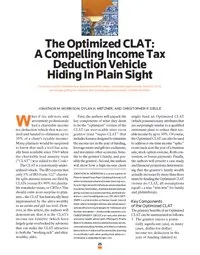
SEE ALSO: “The Optimized CLAT,” co-authored by Jonathon Morrison, is peer-reviewed and was the cover article in the September 2020 issue of Estate Planning, widely viewed as the most esteemed professional journal in the tax and estate planning world.
See also: Optimized CLAT FAQs
The Optimized CLAT (OCLAT) is a special version of a charitable lead annuity trust that has been designed to optimize the tax and economic benefits to the contributor. An OCLAT is ideal for persons seeking to create a “giving engine” for tax-favored philanthropy during their lifetime.
The OCLAT is the only tax planning vehicle in existence that:
- generates a dollar-for-dollar tax deduction in the year of funding (providing immediate tax savings)
- returns an expected 1-5x of the initial contribution back to the contributor
- immediately exempts the contributed assets from the 40% federal gift and estate tax, and
- exempts the transferred assets from the contributor’s personal creditors.
The Optimized CLAT must be funded by December 31 to enjoy a tax deduction this year. The OCLAT may be funded every tax year with up to 30% of the contributor’s annual income (including capital gains from the sale of a business).
Specific benefits include:
Immediate Dollar-for-Dollar Tax Deduction, and Return of 1-5x Contributed Funds. Immediately upon transferring funds into the Optimized CLAT, the contributor enjoys a dollar-for-dollar charitable income tax deduction in that tax year. At the end of the Lock-Up Period (discussed below), the contributor can expect to receive back one to five times the amount of the initial contribution, assuming a reasonable 5-7% rate of return. (Custom financial projection model available upon request.)
Assets Immediately Exempt from Federal Gift and Estate Tax. For clients with large estates, the Optimized CLAT is designed so that:
- the contributed assets are immediately exempt from federal estate taxes (currently imposed at a 40% tax rate), and
- the contribution does not utilize any of the contributor’s lifetime gift exemption when transferred into the trust.
The Optimized CLAT assets can grow to an unlimited amount – when the assets are transferred to children or family members at the end of the Lock-Up Period (discussed below), there are no gift tax or estate taxes paid on the transfer.
Assets Immediately Protected from Creditors, Bankruptcy and Divorce. Finally, upon funding the Optimized CLAT, the assets are also protected from the contributor’s creditors, bankruptcy, and, if single when trust is funded, divorce.
OPTIMIZED CLAT VS. TRADITIONAL INVESTMENT ACCOUNTS
The Optimized CLAT operates much like any other “traditional” investment account, with two main differences:
Charitable Lock-Up Period (No Withdrawals or Loans). The Optimized CLAT has a “Lock-Up Period” selected by the contributor (typically 15-30 years). There is no minimum or maximum term, but the longer the Lock-Up Period, the greater the expected return. During this time, the contributor:
- may invest the assets but not withdraw (or borrow) from the account; and
- must pay taxes on the CLAT’s income using funds outside of the Optimized CLAT.
Payments to Charity In Lieu of Taxes. During the Lock-Up Period, a portion of the assets must be paid from the Optimized CLAT to charities of the contributor’s choosing (including the contributor’s donor advised fund). The amount required to be paid to charities is determined at the outset based on the IRS Section 7520 “benchmark rate” in effect at the time of funding.
The IRS benchmark rate is currently near an all-time low (approximately 1%), minimizing the required payments to charity (which are fixed at the outset and not subject to interest rate changes) and maximizing the amount returned to the contributor at the end of the Lock-Up Period (any asset performance above approximately 1%).
Moreover, the IRS has approved the deferral (back-loading) of the bulk of the charitable payments until the final years of the Lock-Up Period, allowing the assets to potentially triple (or quadruple) before large charitable payments become due. Put simply, taxes are avoided this year in exchange for making donations to charity far off in the future.
20-Year Example: In December 2021, Joe moved $1 million of stocks into an Optimized CLAT and elected a 20-year Lock-Up Period. Joe enjoyed a $1 million deduction on his 2021 tax return and will receive back $500,000 as a tax refund in April 2022 (assuming he withheld 50% federal and estate tax on $1 million ordinary income).
Based on the December 2021 IRS rate (1%), which sets the charitable amounts, Joe must pay 1.16 times the contributed amount ($1.16 million) to charities over the 20-year Lock-Up Period (with approximately 70% of the charitable gifts paid in the final five years).
In year 20, assuming a 7% rate of return, 2.2x ($2.2 million) would be returned to Joe (or could be paid to Joe’s children or family members, free of the 40% gift/estate tax – an additional tax savings of approximately $900,000).
30-Year Example: A 30-year version would pay 1.29x ($1.29 million) to charity and 5.7x ($5.7 million) to Joe, with all assumptions the same.


